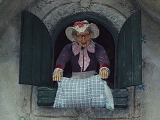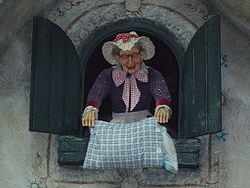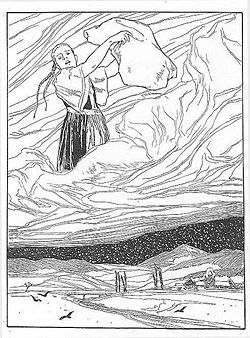
Mother Hulda
Encyclopedia

German language
German is a West Germanic language, related to and classified alongside English and Dutch. With an estimated 90 – 98 million native speakers, German is one of the world's major languages and is the most widely-spoken first language in the European Union....
fairy tale
Fairy tale
A fairy tale is a type of short story that typically features such folkloric characters, such as fairies, goblins, elves, trolls, dwarves, giants or gnomes, and usually magic or enchantments. However, only a small number of the stories refer to fairies...
collected by the Brothers Grimm
Brothers Grimm
The Brothers Grimm , Jacob Grimm and Wilhelm Grimm , were German academics, linguists, cultural researchers, and authors who collected folklore and published several collections of it as Grimm's Fairy Tales, which became very popular...
and first published in 1812 as part of Children's and Household Tales. It was originally known as Frau Holle and is tale number 24.
Synopsis
Mother Hulda tells the tale of a rich widowWidow
A widow is a woman whose spouse has died, while a widower is a man whose spouse has died. The state of having lost one's spouse to death is termed widowhood or occasionally viduity. The adjective form is widowed...
and her daughter and stepdaughter. The widow favored her biological daughter, allowing her to become spoiled and idle, while her stepdaughter was left to do all the work. Every day the stepdaughter would sit outside the cottage and spin
Weaving (mythology)
The theme of weaving in mythology is ancient, and its lost mythic lore probably accompanied the early spread of this art. In traditional societies today, westward of Central Asia and the Iranian plateau, weaving is a mystery within woman's sphere...
beside the well. One day she pricked her finger on the point of the spindle
Spindle
The term spindle may refer to:In textiles and manufacturing:*Spindle , a device to spin fibres into thread*Spindle , is the main rotating part of a machine tool, woodworking machine, etc...
. Leaning over the well to wash the blood away, the spindle fell from her hand and sank out of sight. The stepdaughter feared that she would be punished for losing the spindle, and in a panic she leapt into the well after it. To her surprise, the girl found herself in the other world of Hulda, who kept her as maidservant for several weeks. Hulda was so impressed by the girl's meekness and industry she sent her back to her family, with an apron full of gold.
The mother, thinking that her own daughter should have received the gold, sent the lazy daughter down the well to work for Mother Hulda. Copying her sister, the lazy daughter bloodied her finger and leapt into the well. But Hulda reproved her idle nature by sending her home covered with pitch
Pitch (resin)
Pitch is the name for any of a number of viscoelastic, solid polymers. Pitch can be made from petroleum products or plants. Petroleum-derived pitch is also called bitumen. Pitch produced from plants is also known as resin. Products made from plant resin are also known as rosin.Pitch was...
.
Origins
The exact origin of Mother Hulda is difficult to trace but it is thought that the character originated in Norse mythologyNorse mythology
Norse mythology, a subset of Germanic mythology, is the overall term for the myths, legends and beliefs about supernatural beings of Norse pagans. It flourished prior to the Christianization of Scandinavia, during the Early Middle Ages, and passed into Nordic folklore, with some aspects surviving...
, where she is associated with a number of different deities including Frigg
Frigg
Frigg is a major goddess in Norse paganism, a subset of Germanic paganism. She is said to be the wife of Odin, and is the "foremost among the goddesses" and the queen of Asgard. Frigg appears primarily in Norse mythological stories as a wife and a mother. She is also described as having the power...
and Hel
Hel (being)
In Norse mythology, Hel is a being who presides over a realm of the same name, where she receives a portion of the dead. Hel is attested in the Poetic Edda, compiled in the 13th century from earlier traditional sources, and the Prose Edda, written in the 13th century by Snorri Sturluson...
; also in German, there is an etymologic connection between the name Holle, the name Hel, and the word for hell (Hölle).
Hel
Hel (being)
In Norse mythology, Hel is a being who presides over a realm of the same name, where she receives a portion of the dead. Hel is attested in the Poetic Edda, compiled in the 13th century from earlier traditional sources, and the Prose Edda, written in the 13th century by Snorri Sturluson...
is the queen of Hel
Hel (realm)
In Norse mythology, Hel, the location, shares a name with Hel, a female figure associated with the location. In late Icelandic sources, varying descriptions of Hel are given and various figures are described as being buried with items that will facilitate their journey to Hel after their death...
, the Norse underworld, and described in Norse mythology
Norse mythology
Norse mythology, a subset of Germanic mythology, is the overall term for the myths, legends and beliefs about supernatural beings of Norse pagans. It flourished prior to the Christianization of Scandinavia, during the Early Middle Ages, and passed into Nordic folklore, with some aspects surviving...
as a half-dead, half alive monster, but in German mythology she was viewed with some beneficence, as a more gentle form of death and transformation. In this context, Mother Hulda is connected with Hertha, the goddess of peace and fertility, otherwise known as Hlodyn in the Edda
Edda
The term Edda applies to the Old Norse Poetic Edda and Prose Edda, both of which were written down in Iceland during the 13th century in Icelandic, although they contain material from earlier traditional sources, reaching into the Viking Age...
. Hlodyn herself was more commonly referred to as Jord, the personification of the primitive, unpopulated, and uncultivated Earth. She is one of the wives of the chief god Odin
Odin
Odin is a major god in Norse mythology and the ruler of Asgard. Homologous with the Anglo-Saxon "Wōden" and the Old High German "Wotan", the name is descended from Proto-Germanic "*Wodanaz" or "*Wōđanaz"....
and the mother of the god Thor
Thor
In Norse mythology, Thor is a hammer-wielding god associated with thunder, lightning, storms, oak trees, strength, the protection of mankind, and also hallowing, healing, and fertility...
. Since the term mother goddess is used interchangeably in various texts across Europe it is possible that some confusion exists over the exact status of Jord and Frigg in this context.
In early Germanic mythology
Germanic mythology
Germanic mythology is a comprehensive term for myths associated with historical Germanic paganism, including Norse mythology, Anglo-Saxon mythology, Continental Germanic mythology, and other versions of the mythologies of the Germanic peoples...
however, Hulda
Holda
In Germanic folklore as established by Jacob Grimm, Frau Holda or Holle is the supernatural matron of spinning, childbirth and domestic animals, and is also associated with winter, witches and the Wild Hunt...
was known as the goddess of marriage
Marriage
Marriage is a social union or legal contract between people that creates kinship. It is an institution in which interpersonal relationships, usually intimate and sexual, are acknowledged in a variety of ways, depending on the culture or subculture in which it is found...
. She was a beneficent deity, the patroness and guardian of all maidens.
Marija Gimbutas
Marija Gimbutas
Marija Gimbutas , was a Lithuanian-American archeologist known for her research into the Neolithic and Bronze Age cultures of "Old Europe", a term she introduced. Her works published between 1946 and 1971 introduced new views by combining traditional spadework with linguistics and mythological...
names Hulda (or Holda, Holla, Holle) as having originally been an ancient Germanic supreme goddess who predates most of the German pantheon, including deities such as Odin, Thor, Freya and Loki, continuing traditions of pre-Indo-European Neolithic Europe
Neolithic Europe
Neolithic Europe refers to a prehistoric period in which Neolithic technology was present in Europe. This corresponds roughly to a time between 7000 BC and c. 1700 BC...
.
When Christianity
Christianity
Christianity is a monotheistic religion based on the life and teachings of Jesus as presented in canonical gospels and other New Testament writings...
slowly replaced Scandinavian paganism during the early Middle Ages
Middle Ages
The Middle Ages is a periodization of European history from the 5th century to the 15th century. The Middle Ages follows the fall of the Western Roman Empire in 476 and precedes the Early Modern Era. It is the middle period of a three-period division of Western history: Classic, Medieval and Modern...
, much of the old customs were gradually lost or assimilated into Catholic tradition. By the end of the High Middle Ages
High Middle Ages
The High Middle Ages was the period of European history around the 11th, 12th, and 13th centuries . The High Middle Ages were preceded by the Early Middle Ages and followed by the Late Middle Ages, which by convention end around 1500....
, Scandinavian paganism
Paganism
Paganism is a blanket term, typically used to refer to non-Abrahamic, indigenous polytheistic religious traditions....
was almost completely marginalized and blended into rural folklore, in which the character of Mother Hulda eventually survived.

Holda
In Germanic folklore as established by Jacob Grimm, Frau Holda or Holle is the supernatural matron of spinning, childbirth and domestic animals, and is also associated with winter, witches and the Wild Hunt...
, Holle and Holla were all names to denote a single Goddess. One who rules the weather; sunshine, snow and rain. Hulda is also related to the Germanic figure of Perchta
Perchta
Perchta or Berchta , also commonly known as Percht and other variations, was once known as a goddess in Southern Germanic paganism in the Alpine countries...
. She dwells at the bottom of a well, rides a wagon, and first taught the craft of making linen from flax. Hulda is the goddess to whom children who died as infants go, and alternatively known as both the Darth Großmutter (Dark Grandmother) and the Weissfrau (White Lady), elements which are more typically associated with the Grimm's fairy tale as well.
Her connection to the spirit world through the magic of spinning and weaving
Weaving (mythology)
The theme of weaving in mythology is ancient, and its lost mythic lore probably accompanied the early spread of this art. In traditional societies today, westward of Central Asia and the Iranian plateau, weaving is a mystery within woman's sphere...
has associated her with witchcraft
Witchcraft
Witchcraft, in historical, anthropological, religious, and mythological contexts, is the alleged use of supernatural or magical powers. A witch is a practitioner of witchcraft...
in Catholic German folklore.
The legend itself, as it was eventually passed to the Grimm Brothers, originates from oral traditions in Central Germany in what is now known as Hesse
Hesse
Hesse or Hessia is both a cultural region of Germany and the name of an individual German state.* The cultural region of Hesse includes both the State of Hesse and the area known as Rhenish Hesse in the neighbouring Rhineland-Palatinate state...
. It was told to them by Henriette Dorothea Wild (whom Wilhelm Grimm married in 1825) with more details added in the second edition (1819). It is still common expression in Hesse to say "Hulda is making her bed" when it is snowing, that is, she shakes her bed and out comes snow from heaven!
Analysis
According to the Aarne and Thompson classification system of fairy tales, Mother Hulda is a story of type 480, The Kind and the Unkind Girls. Others of this type include Shita-kiri SuzumeShita-kiri Suzume
, translated literally into "Tongue-Cut Sparrow", is a traditional Japanese fable telling of a kind old man, his avaricious wife and an injured sparrow...
, Diamonds and Toads
Diamonds and Toads
Diamonds and Toads or Toads and Diamonds is a French fairy tale by Charles Perrault, and titled by him "Les Fées" or "The Fairies." Andrew Lang included it in The Blue Fairy Book....
, The Three Heads in the Well
The Three Heads in the Well
The Three Heads in the Well is a fairy tale collected by Joseph Jacobs in English Fairy Tales.It is Aarne-Thompson tale 480, the kind and the unkind girls. Others of this type include Shita-kiri Suzume, Diamonds and Toads, Mother Hulda, Father Frost, The Three Little Men in the Wood, The Enchanted...
, Father Frost
Father Frost (fairy tale)
Father Frost is a Russian fairy tale collected by Alexander Afanasyev in Narodnye russkie skazki. Andrew Lang included it, as "The Story of King Frost", in The Yellow Fairy Book.It is Aarne-Thompson type 480, The Kind and the Unkind Girls...
, The Three Little Men in the Wood
The Three Little Men in the Wood
The Three Little Men in the Wood or The Three Dwarfs is a German fairy tale collected by the Brothers Grimm, number 13. Andrew Lang included it in The Red Fairy Book, and a version of the tale appears in A Book of Dwarfs by Ruth Manning-Sanders.It is Aarne-Thompson type 403B, the black and the...
, The Enchanted Wreath
The Enchanted Wreath
The Enchanted Wreath is a Scandinavian fairy tale, collected in Benjamin Thorpe in his Yule-Tide Stories: A Collection of Scandinavian and North German Popular Tales and Traditions...
, The Old Witch
The Old Witch
The Old Witch is an English fairy tale collected by Joseph Jacobs in his 1894 book, More English Fairy Tales.Also included within A Book of Witches Ruth Manning-Sanders and A Book of British Fairy Tales by Alan Garner....
, and The Two Caskets
The Two Caskets
The Two Caskets is a Scandinavian fairy tale included by Benjamin Thorpe in his Yule-Tide Stories: A Collection of Scandinavian and North German Popular Tales and Traditions. Andrew Lang included it in The Orange Fairy Book....
. Literary variants include The Three Fairies
The Three Fairies
The Three Fairies is an Italian literary fairy tale written by Giambattista Basile in his 1634 work, the Pentamerone.It is Aarne-Thompson tale 480, the kind and the unkind girls, and appears to stem from an oral source...
and Aurore and Aimée
Aurore and Aimée
Aurore and Aimée is a French literary fairy tale written by Jeanne-Marie Le Prince de Beaumont. Like her better known tale Beauty and the Beast, it is among the first fairy tales deliberately written for children....
.
Mother Hulda is one of Germany's most durable female legendary figures and one who without doubt represents a pre-Christian heathen deity who survived in popular belief and in the memory of common people well into the nineteenth century.
See also
- PerchtaPerchtaPerchta or Berchta , also commonly known as Percht and other variations, was once known as a goddess in Southern Germanic paganism in the Alpine countries...
- Kallo and the GoblinsKallo and the GoblinsKallo and the Goblins is a Greek fairy tale. Fani Papalouka, Nikolaos Politis, and Haris Sakellariou collected variants of the story.-Synopsis:...
- The MonthsThe MonthsThe Months is an Italian literary fairy tale written by Giambattista Basile in his 1634 work, the Pentamerone.-Synopsis:Cianne and Lise were brothers, and Cianne was rich and Lise poor. Lise set out to wander the world. He met with twelve youths who welcomed him, and asked him about the months...
- True and UntrueTrue and UntrueTrue and Untrue is a Norwegian fairy tale collected by Asbjørnsen and Moe. It is Aarne-Thompson type 613, The Two Travelers: Truth and Falsehood.-Synopsis:...

